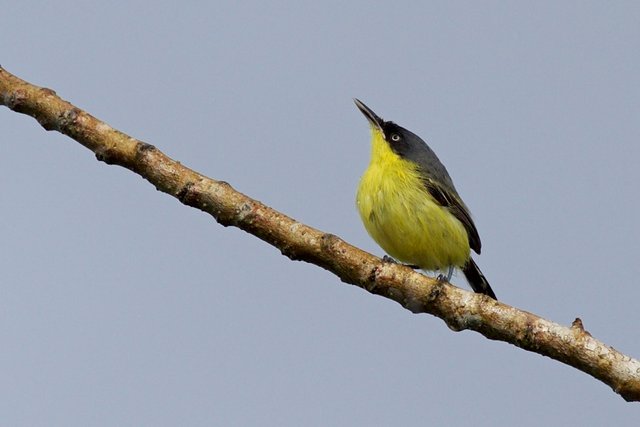One week of bird(watch)ing - 6 FTE birds spotted

Arrowhead Piculet (Picumnus minutissimus)
Last week was a fantastic week for birding. I spotted 6 birds for the first time ever (FTE). Not that these birds are rare, but sometimes you just have to be lucky to see them. The pictures that I took are not that great, some are really bad, but good enough to identify them and add them to my very short list of birds spotted so far in Suriname.
The other birds in this post are the better or more interesting photographs that I took last week that I would like to share, especially with my folks back in Holland. The first FTE is the Arrowhead Piculet that you see above. It's a very small woodpecker.

Lesser Nighthawk (Chordeiles acutipennis)
A couple of days ago, when I looked outside, I saw something lying on the street. I could not clearly see what it was but it turned out to be a nightjar. A bird that hunts for insects during the night. It was probably attracted by the insects that hover around the streetlight. Crappy picture but good enough to identify it.

Yellow-bellied Elaenia (Elaenia flavogaster)
The Yellow-bellied Elaenia is apparently a very common bird which I never saw before and never seen again since I saw it a week ago.

Fork-tailed Flycatcher (Tyrannus savana)
During the last week I saw this bird fly over our house a couple of times and always around the same time in the evening. It was very high in the sky but I knew it was something that I had never seen before. The really long tail feathers made it easy to identify it. It is a Fork-tailed Flycatcher, I hope that one day it will do me the honour to land in my garden.

Lined Seedeater (Sporophila lineola)
The female Lined Seedeater is almost identical to the female Wing-barred Seedeater that you can see in the next picture. The main difference is that the bill of the female Lined Seedeater is brown instead of black. The male is more easily recognisable but I haven't seen one yet.

Wing-barred Seedeater (Sporophila Americana)

Black-spotted Barbet (Capito niger)
This beautiful coloured Black-spotted Barbet was high up in a tree at the edge of the forest where they look for fruit or insects to eat. I saw it early in the morning yesterday and it was the sixth FTE of last week.


Green-throated Mango (Anthracothorax viridigula)
It has been while since I saw a Green-throated Mango in our garden. Nowadays other hummingbirds are being chased away by this lady in the next picture. She has build a nest and doesn't allow any competition.

Glittering-throated emerald (Amazilia fimbriata)

Yellow-hooded Blackbird (Chrysomus icterocephalus)
I spotted the Yellow-hooded Blackbird for the first time two weeks ago. This is the female, last week I spotted the male.

The male Yellow-hooded Blackbird is stunningly coloured. Unfortunately it will fly away if one tries to approach it to take a better picture.

Red-breasted Blackbird (Sturnella militaris)
Another member of the blackbird family is the Red-breasted Blackbird. This bird is less shy and one can clearly see why it's called a Red-breasted Blackbird. The female is more brown and hides away in the fields.

Common Tody-Flycatcher (Todirostrum cinereum)
I saw the Common Tody-flycatcher for the first time a month ago. Now I see them every day. There are a couple of them in the garden and it looks like they are here to stay.

Spotted Tody-Flycatcher (Todirostrum maculatum)
Another tody-flycatcher is the Spotted Tody-flycatcher. I've seen this small bird only a couple of times and last week for the first time in our garden.

Rusty-margined Flycatcher (Myiozetetes cayanensis)
The Rusty-margined Flycatcher looks almost identical to the Great Kiskadee. The main visible differences are its smaller bill and the band of white that doesn't completely run around its head. But they are more easily identifiable by their song and behaviour. The Great Kiskadee in the next picture, that I took two weeks ago, is less shy and way more noisy.

Great Kiskadee (Pitangus sulphuratus)

I hope you enjoyed the birds in this post from last week. Thank you for visiting my blog and happy birding.

Great post. I call FTE birds "lifers" or "life list birds" but like the FTE moniker. You've had a great w.eek. Do you use eBird? if so what's your ebird user name? I included this in the "best posts of the week" article on this blog. Keep it up
Thank you so much. I don't know the terminology used in birding, I will use your suggestions from now on. I know about eBird and was thinking to make a new account and start submitting my observations. Thank you for including me on your best post of the week article.
You got a plankton sized upvote from @worksinsane because your post appeared in the We Curate quality post search tool. It is a web art thingy thing that searches posts which fulfill predetermined rules. Upvoting isn't automated, @worksinsane reads posts before upvoting.
For more information read the latest post: https://steemit.com/wecurate/@worksinsane/we-curate-9
Well, thank you for your upvote. It's much appreciated, even if it's plankton sized.